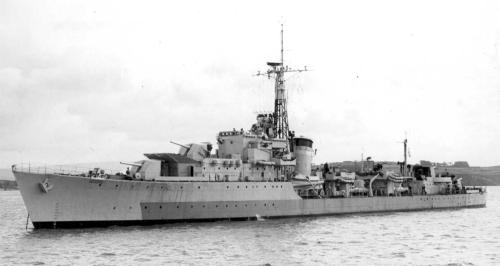Ordered in February 1942, The Caesar Class was the 11th destroyer flotilla of the emergency war programme. They were of the same design as the earlier ‘Emergency’ flotillas and almost identical to the preceding ‘Z’ or Zephyr Class in which the traditionaI4.7-in (120-mm) gun had been replaced by a new weapon of 4.5-in (114.3-mm) calibre. Having reached the end of the alphabet with the 10th Flotilla the new group were initially given names beginning with a variety of letters, but it was then decided to give them ‘c’ names as the original ‘c’ Class had been transferred to the RCN and renamed. The final three emergency flotillas were also given ‘c’ names, and to distinguish between them they were designated the ‘Ca’ (Caesar), ‘Ch’ (Chequers), ‘Co’ (Cossack) and ‘Cr’ (Crescent) Classes.
They were designed to carry a close-range armament of one twin 40-mm (1.57-in) Hazemeyer mounting amidships, two twin 20-mm (0.79-in) abaft the funnel and two single 20-mm in the bridge wings. However, the Caprice was completed with a quadruple 2-pdr porn-porn in place of the twin 40-mm and the Cassandra mounted twin 20-mm guns in her bridge wings instead of singles. In 1945 the majority had their 20-mm mountings replaced by four 2-pdr pom-poms but Cassandra was not altered, while Caesar mounted two 2-pdrs and one 40-mm gun and the Cavendish was fitted with three 2-pdrs only. These alterations were made to increase their firepower for defence against kamikaze attacks.
The class completed between April 1944 and February 1945, the Caprice being the first 4.5-in (114.3-mm) gunned destroyer to enter service, as the first of the ‘Z’ Class did not complete until July 1944. Initially they served with the Home Fleet as the 6th Destroyer Flotilla and operated mainly in northern waters where both Cassandra and Cavalier covered Russian convoys. On December 11, 1944, while escorting RA62, the Cassandra was torpedoed by a U-Boat, about 7.62 m (25 ft) of her bow being blown away. She was towed to Murmansk, stern first, where temporary repairs were carried out by the Russians. She returned to the UK in June 1945 but home dockyards were fully occupied. The remainder of the class were transferred to the Far East and Pacific during 1945 but the majority arrived too late to take an active part in the war against Japan. All returned to Britain in 1946 and were placed in reserve until the 1950s.
In 1953 the Carron was taken in hand at Chatham dockyard for a two-year modernization. A new bridge, similar to that in the Daring Class, replaced the original structure and a new director and remote power control were provided for the main armament. The after bank of torpedo tubes was replaced by a deckhouse on which a twin Mk V Bofors was mounted and X 4.5-in (114.3-mm) mounting was supplanted by two ‘Squid’ antisubmarine mortars. All of the original close range AA weapons were removed. The rest of the class were modernized in the same manner between 1954 and 1963 the only major variation being in the last four (Caesar, Cambrian, Caprice and Cassandra) which were fitted with enclosed frigate-type bridges instead of the open destroyer type.
In 1963 the Cavendish became the first ship to be fitted with the ‘Seacat’ GWS which replaced the twin 40-mm (1.57-in) gun mounting. The Cavalier was similarly fitted in 1966. In 1971 a race was held between the Cavalier and the frigate Rapid to settle an argument over which was the fastest ship in the navy. The Cavalier won by a very narrow margin after averaging 31.8 knots over 64 miles. Most of the class were sold for scrap between 1967 and 1975, but the Cavalier which is one of the last examples of her type, has been preserved and is permanently moored at Southampton.
Caesar, Cavendish (built by J Brown)
Cambrian, Carron (built by Scotts’)
Caprice, Cassandra (built by Yarrow)
Carysfort, Cavalier (built by White).
Displacement: 1710 tons (standard), 2530 tons (full load)
Length: 110.5 m (362 ft 9 in)
Beam: 10.9 m (35 ft 9 in)
Draught: 3.04 m (10ft) mean
Machinery: 2-shaft geared steam turbines, 40 000 shp=34 knots
Armament: 4 4.5-in (114.3- mm) (4×1); 2 40-mm (1.57-in) (1 x2); 6 20-mm (0.79-in) (2×2+2×1); 8 21-in (53-cm) torpedo tubes (2×4)
Crew: 186
